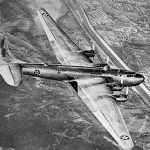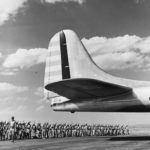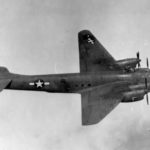Bomber in flight
Take off
Bomber seen from an AT‑6C Texan observation aircraft
XB-19
XB-19 1941
XB-19 in flight 1941
XB-19 nears completion on factory floor, Douglas. Santa Monica, 1940
XB-19A front view
XB-19A in a hangar
Bomber under construction at Douglas Aircraft Plant
Tail of a Douglas XB-19 1941
XB-19 does an engine test run, 1941
XB-19 is readied for flight and handling testing
XB-19 warming up its engines
Douglas XB-19A 38-471 white 71 in flight
XB-19 and P-40 in 1941
XB-19A with Allison V-3420-11 engines
XB-19 serial 38-471, in flight over Santa Monica with an AT·6. It first flew on June 27,1941,
XB-19 with Olive Drab and Neutral Gray camouflage
Douglas XB-19 in flight. B-19 was the largest aircraft to enter USAAF service until the B-36.
Bomber XB-19 with gears down
The nearly completed XB‑19
XB-19 38-471 in 1942
Douglas XB-19 near Wright Field
Douglas XB-19 38-471 in flight 1942
Soldiers washing Douglas XB-19 at March Field 1941
Lieutenant pictured talking on the phone in rear section of the fuselage of a XB-19
Clover Field June 17, 1941
The XB-19 was an experimental long-range bomber developed under the secretive ‘Project D’ initiated by the US Army Air Corps on February 5, 1935. This project led to the creation of the largest aircraft ever produced by the Douglas Aircraft Company. From the start, the Air Corps emphasized that the program was experimental, aimed at advancing military aviation by exploring the farthest limits of future capabilities. Despite fulfilling and even exceeding many contractual requirements, only one XB-19 (s/n 2001, serial 38-471) was ever constructed.
The Air Corps secured the necessary approvals, which led to the preparation of Type Specification X-203 by the Matériel Division and preliminary discussions with both Douglas and Sikorsky. During a meeting with Douglas on June 5, 1935, a timeline was set: preliminary design was to begin on July 31, 1935, detailed design on January 31, 1936, and the completion of the physical aircraft by March 31, 1938. However, this schedule faced multiple delays due to the project’s complexity and insufficient funding, resulting in the XB-19’s completion being pushed back to May 1941, over three years behind schedule. A contract for preliminary and detailed design, along with the construction and testing of critical components such as the wing center section, engine nacelles, and undercarriage, was sent to Douglas in October 1935 and approved on October 18. After evaluating mock-ups from both Douglas and Sikorsky, Douglas was chosen as the project’s winner. Progress was slow, however, as limited military budgets between December 1935 and November 1937 meant only piecemeal procurement was possible. During this period, the original 1,600 hp Allison XV-3420-1 liquid-cooled engines were replaced with 2,000 hp Wright R-3350 air-cooled radial engines. Douglas also borrowed a Douglas OA-4A from the Air Corps to test a tricycle undercarriage, the type selected for the XB-19. Finally, as funding became available, construction of the prototype – now re-designated XB-19 – was authorized on March 8, 1938.
Douglas, having spent more of its own funds than expected and needing its design team for other projects, began losing interest in the XB-19. On August 30, 1938, Douglas suggested canceling the project, citing design obsolescence and unexpected weight increases. However, the Matériel Division insisted on continuing the project, albeit slowly. Two years later, the Air Corps acknowledged the XB-19’s reduced military relevance by removing its secret classification. Nevertheless, upon its completion, the XB-19 was still the largest American aircraft until the Convair B-36 was completed in August 1946.
The XB-19, completed in May 1941, was an enormous all-metal, low-wing monoplane with a stressed-skin design and a retractable tricycle undercarriage. It had an impressive wingspan of 212 ft (64.62 m), a maximum gross weight of 162,000 lb (73,482 kg), and two main wheels each 8 ft (2.44 m) in diameter. The aircraft was powered by four 2,000 hp Wright R-3350-5 eighteen-cylinder radial engines, each driving a 17 ft (5.18 m) diameter, three-blade constant-speed metal propeller. To achieve the desired range, the engines were supplied with fuel from integral tanks with a capacity of 10,350 US gallons (38,178 liters), with auxiliary tanks capable of holding 824 gallons (3,119 liters) fitted in the bomb bay. With a reduced fuel load, the XB-19 could carry a maximum bomb load of 37,100 lb (16,828 kg) both internally and on ten external wing racks. Its defensive armament (not installed at the time of completion) included a 37-mm cannon and a 0.30-inch machine gun in the nose and forward dorsal turrets, a 0.50-inch machine gun in five locations (tail position, rear dorsal turret, ventral turret, and port and starboard positions), and a 0.30-inch machine gun on each side of the bomb-aimer’s station and below the tailplane. The XB-19 typically carried a combat crew of sixteen, but it could also accommodate two additional flight mechanics and a six-man relief crew in a compartment with eight seats and six bunks. To serve this large crew during long flights, a fully equipped galley was installed for preparing hot meals.
The XB-19’s initial taxiing tests began on May 6, 1941, but its first flight, scheduled for May 17, was delayed three times due to severe brake issues, engine backfires, and the need to rewire the propeller-pitch control system. Finally, on June 27, 1941, a crew of seven, led by Major Stanley M. Ulmstead, successfully completed the XB-19’s 55-minute maiden flight from Clover Field in Santa Monica to March Field. The flight was uneventful, earning Douglas a congratulatory message from President Roosevelt. After this flight, the XB-19 underwent a 30-hour manufacturer’s flight-test program before being tentatively accepted by the Air Corps in October 1941. Following the attack on Pearl Harbor, the aircraft was camouflaged, armed, and eventually transferred to Wright Field on January 23, 1942, after accumulating 70.05 hours of flight time.
In June 1942, after minor modifications and the installation of improved brakes, the XB-19 was officially accepted, with the total contract cost to the US Government amounting to $1,400,064. However, Douglas Aircraft Company had spent nearly $4,000,000 of its own funds on the project. Over the next eighteen months, the aircraft and its engines were extensively tested by the USAAF, providing valuable data that influenced the design of other large aircraft, including the Boeing B-29 and the Convair B-36. During testing, the XB-19 performed well, though it encountered engine cooling issues, which required the cooling gills to remain open during long flights. This reduced the aircraft’s maximum speed from 224 mph at 15,700 ft (360 km/h at 4,785 m) to 204 mph (328 km/h) at the same altitude.
Eventually, the XB-19 was converted into a cargo aircraft at Wright Field and fitted with four 2,600 hp Allison V-3420-11 twenty-four-cylinder liquid-cooled engines, the production version of the original powerplant. Re-designated XB-19A, it achieved a top speed of 265 mph (426 km/h) and no longer faced cooling problems. Over the next two and a half years, the XB-19A was moved between several airfields in Ohio – Wright Field, Patterson Field, Lockbourne Air Base, and Clinton County Air Base – as its importance diminished. On August 17, 1946, the XB-19A made its final flight to Davis-Monthan Field in Arizona, where it was stored until it was scrapped three years later. This marked the end of the aircraft that Major General George H. Brett had famously dubbed the “Douglas Flying Behemoth.”
Specifications :
XB-19 | XB-19A | |
crew | 16 | |
span | 64,62 m (212 ft) | 64,62 m (212 ft) |
lenght | 40,34 m (132 ft 4 in) | 40,34 m (132 ft 4 in) |
height | 12,8 m (42 ft) | 12,8 m (42 ft) |
wing area | 398,091 m² (4,285 sq ft) | 398,091 m² (4,285 sq ft) |
empty weight | 39009 kg (86,000 lb) | 41912 kg (92,400 lb) |
loaded weight | 65503 kg (140,000 lb) | 63607 kg (140,203 lb) |
max weight | 73482 kg (162,000 lb) | |
wing loading | 159,5 kg/m² (32,6 lb/sq ft) | 159,8 kg/m² (32,7 lb/sq ft) |
max speed | 360 km/h (224 mph) at 4785 m | 426 km/h (265 mph) at 6095 m |
cruising speed | 217 km/h (135 mph) | 298 km/h (185 mph) |
rate of climb | 3,3 m/s (650 ft/min) | |
service ceiling | 7010m (23,000 ft) | 11885 m (39,000 ft) |
range | 8369 km (5,200 miles) | 6759 km (4,200 miles) |
max range | 12408 km (7,710 miles) | |
powerplant | Wright R-3350-5, 18 cylinder, air-cooled radials 2,000 hp , driving threeblade constant-speed propellers of 5,18 m (17 ft) diameter | Allison V-3420-11 turbocharged 24 cylinder, liquid-cooled, 2,600hp (1,940kW), driving fourblade propellers |
fuel | 39179 l (10,350 US gallons) + 3120 l (824 gal) in bomb bay | |
armament | 5 x 12,7 mm, 6×7,62 mm, 2×37 mm, | |
bombs | normal: 8480 kg (18,700 lb), max: 16828 kg (37,100 lb) with reduced fuel load |
Bibliography:
- William Wolf: DOUGLAS XB-19 America’s Giant World War II Intercontinental Bomber; Osprey X‑PLANES 16
- Rene J. Francillon: McDonnell Douglas Aircraft since 1920 Volume I, Putnam Aeronautical Books
- Lloyd S. Jones: U.S. Bombers
- Kev Darling: American X & Y Planes, Volume 1 – Experimental Aircraft to 1945, Crowood 2010
- Robert A. Mann – The B-29 Superfortress Chronology 1934-1960; 2009
- Office of Air Force History and U.S. Air Force – The Development of Air Doctrine in the Army Air Arm 1917-1941
- International Air Power Review Volume 5, AIRtime Publishing



























